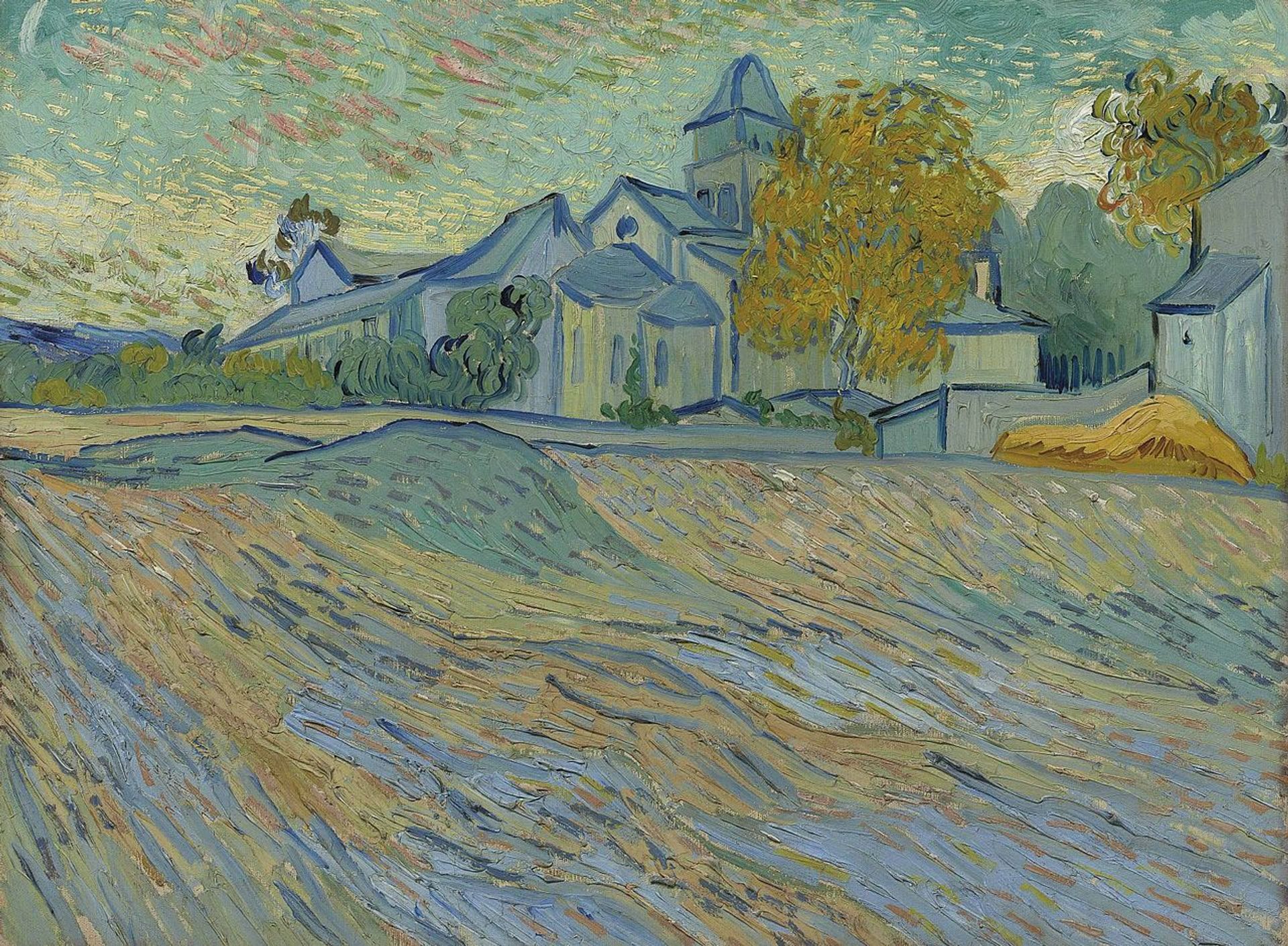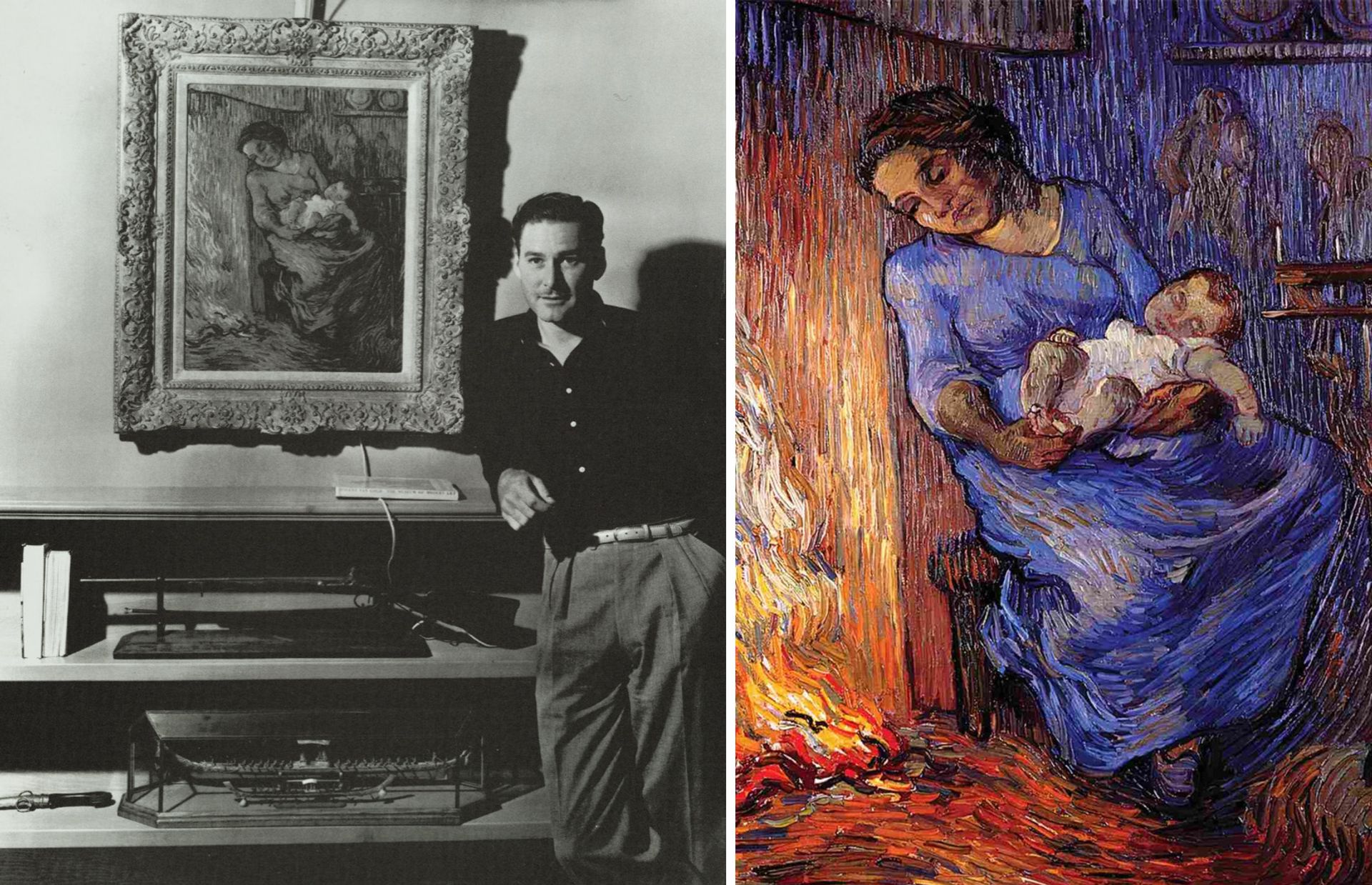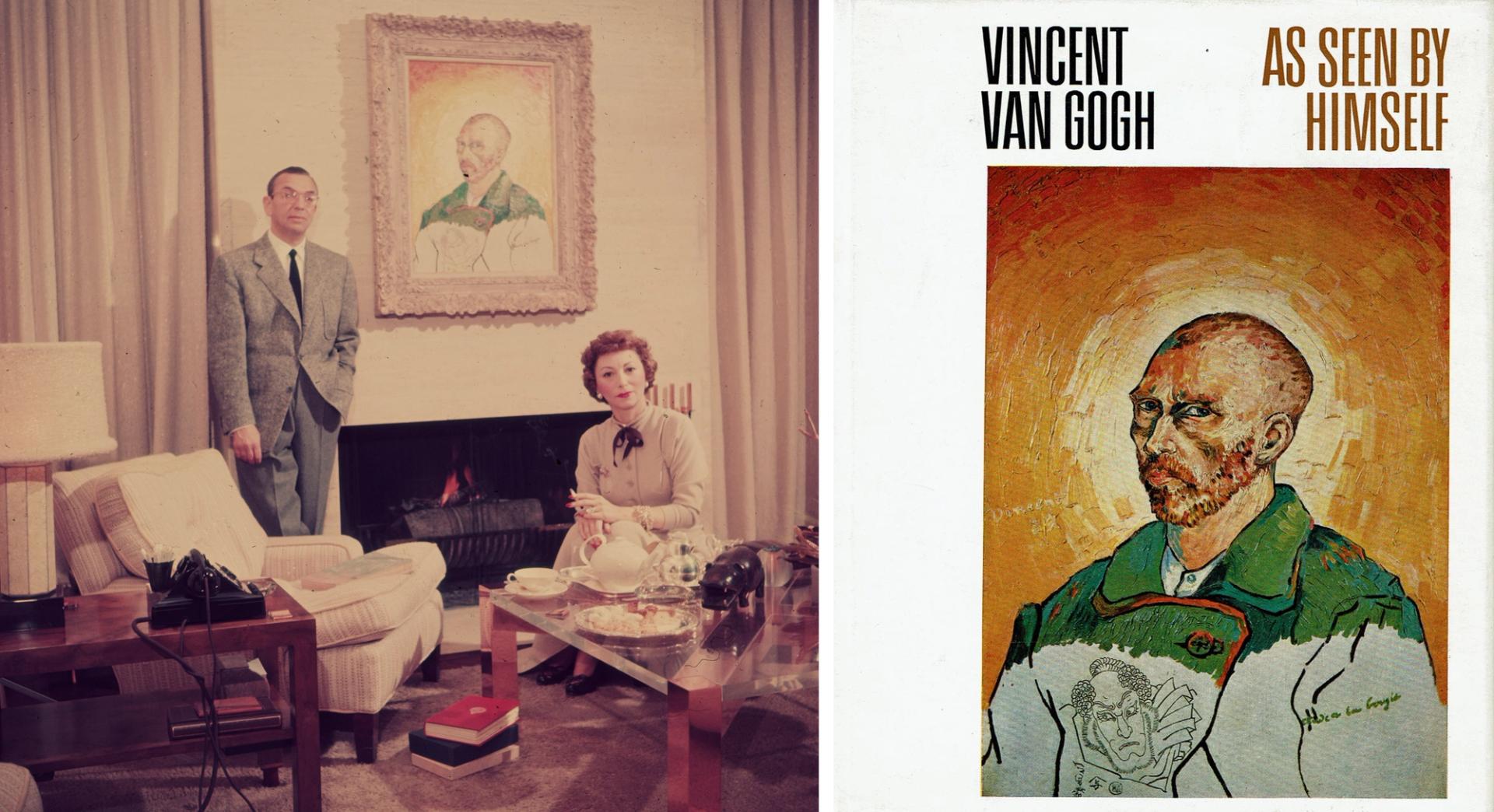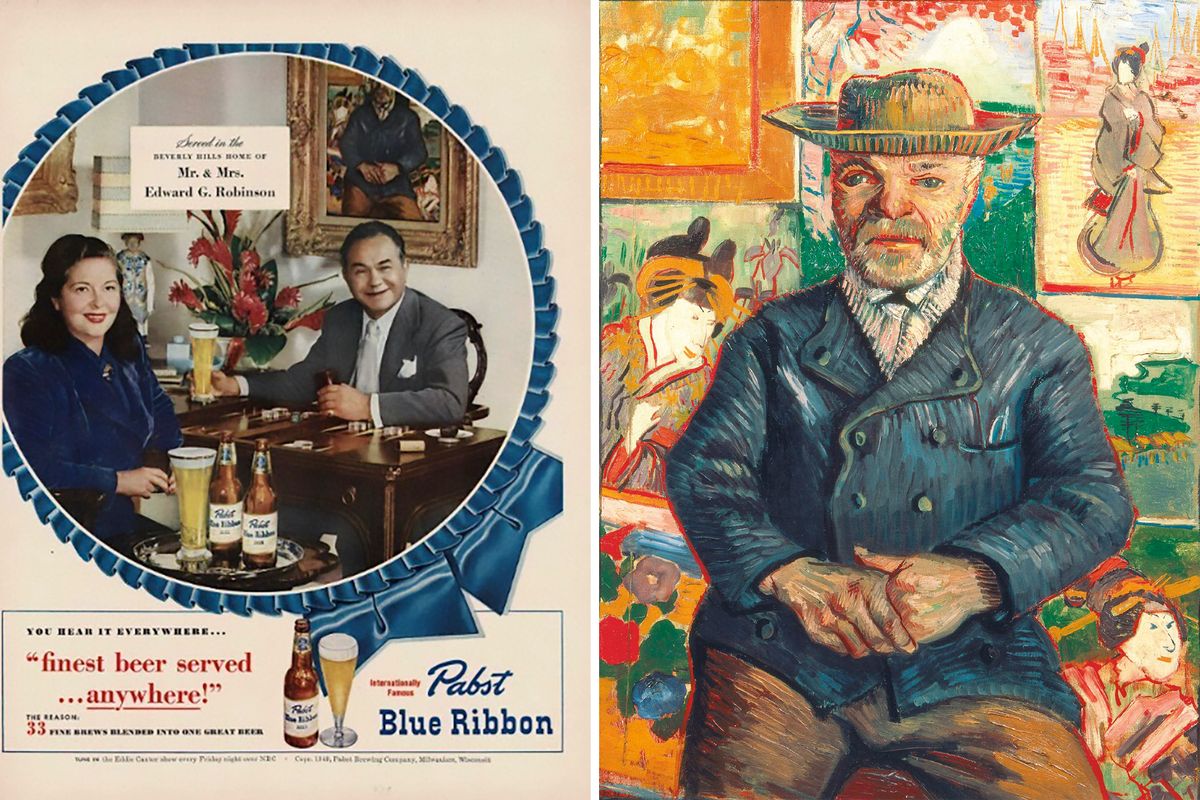Some of the finest Van Gogh paintings ended up in Hollywood in the mid-20th century, as producers and performers vied to show off their success. Van Gogh, the tragic figure who could have come out of a film, certainly fitted the bill. And it comes as no surprise that the Lust for Life, starring Kirk Douglas, was launched out of Hollywood in 1956.
Van Gogh in America, the exhibition now showing at the Detroit Institute of Arts (until 22 January 2023), ends with a section on Hollywood. As Rachel Esner, an Amsterdam art historian, points out in a fascinating essay in the Detroit catalogue: “What these nouveaux riches hoped to gain from associating themselves with Van Gogh’s life and legend was first and foremost cultural status.”
The actor Edward Robinson (1893-1973), who appeared in more than a hundred films, was hardly shy about proclaiming his ownership of Portrait of Père Tanguy (autumn 1887), the paintseller who was depicted against a background of Japanese prints. Having acquired the Van Gogh in 1941, Robinson starred a few years later in a magazine advertisement for Pabst Blue Ribbon beer. Edward and his wife Gladys are enjoying their large glasses of lager, overlooked by the Van Gogh portrait hanging behind them.
When asked about how he felt about the paintings hanging in his Beverly Hills mansion, Robinson responded: “I just sit there in front of them and have the surprise pleasure of imagining I am painting.” Along with the Tanguy portrait, he also owned the Arles landscape The Old Willows (April 1889). This had been acquired in 1938 from the London dealer Alex Reid & Lefevre (run by the son of Alexander Reid, who had befriended Van Gogh in Paris in 1887).
In 1956 Edward and Gladys faced an acrimonious divorce and the following year the magnificent art collection had to be sold off. The Van Goghs then went to the Greek shipping tycoon Stavros Niarchos, who died in 1996 (they are still believed to remain with his descendants).

Van Gogh’s View of the Asylum and Chapel of Saint-Paul-de Mausole (autumn 1889), once owned by Elizabeth Taylor (now in a private collection)
Elizabeth Taylor (1932-2011) owned a fine Van Gogh, View of the Asylum and Chapel of Saint-Paul-de Mausole (autumn 1889, now in a private collection). It had been bought for her through her father in 1963 for £92,000. After she married the actor Richard Burton (her fifth of seven husbands), the picture would sometimes hang in their yacht, Kalizma.
In 2004 View of the Asylum and Chapel of Saint-Paul-de Mausole was subject to a Nazi-era spoliation claim from the descendants of the German Jewish collector Margarete Mauthner, but this was eventually rejected by the US courts. The painting was then sold at Christie’s in 2012, just after Taylor's death, when it fetched £10m (it was later resold at auction in 2018 for $40m).

Errol Flynn at home with his Van Gogh (photograph, mid 1940s) and Van Gogh’s The Husband is at Sea (October 1889) Photo credit: Robert Matzen and Michael Mazzone
Actor Errol Flynn (1909-59) was best known for his romantic roles (and hedonistic lifestyle and highly questionable treatment of women). In 1943-44 he paid $48,000 for The Husband is at Sea (October 1889), Van Gogh’s painted version of an 1889 image by the French artist Virginie Demont-Breton.
Soon after its acquisition, Flynn dramatically described it as having been “smuggled out of Holland just before the Nazis moved in”. This is certainly not something one would brag about in recent decades, when there has been great concern about forced sales during the Nazi era.
But despite Flynn’s extravagant statement, the picture’s provenance seems clear: it came from Paris-based Paul Gachet Jr, the son of the doctor who had treated Van Gogh in 1890, via a respected Amsterdam dealer.
The Husband is at Sea was sold in the mid-1960s, after Flynn’s death, and was last auctioned in 2014, when it fetched £16.9m at Sotheby's. (Meanwhile, in 2000, Demont-Breton’s original had sold for $99,500, a minute fraction of Van Gogh’s copy).

Van Gogh’s L’Arlesienne (February 1890) Credit: Galleria Nazionale d’Arte Moderna, Rome
Film producer Harold Hecht (1907-85) owned Van Gogh’s L’Arlesienne (February 1890, now in Rome’s Galleria Nazionale d’Arte Moderna), a stylised portrait of Marie Ginoux, as well as an Arles landscape drawing of The Plain of La Crau (May 1888, now in a private collection, Texas).
One of Hecht’s rival producers, William Goetz (1903-69), had mixed success with his Van Goghs. He bought Vase with Carnations (summer 1886), which he briefly owned in the late 1940s. After passing through other hands it was bequeathed to the Detroit Institute of Arts in 1990.
Shortly afterwards, it was suggested that the still life was a fake and the museum admitted that it might have been painted by a 1920s imitator. However, more recent research has confirmed its authenticity and in 2019 the painting was formally accessioned into the collection.

William Goetz and his wife with their “Van Gogh” (1952) and the fake Study by Candlelight on the jacket of a book by Heinz Lieser (1963) Photo: Slim Aarons/Getty Images; Credit: Book published by Beyer Leverkusen, Germany
A much more serious question of attribution is raised by a bizarre Van Gogh “self-portrait” which was discovered in a Paris cafe in 1948 and bought the following year by Goetz. This strange painting appears to be a self-portrait, but with the lower-left corner incorporating a Japanese motif in outline.
Entitled Study by Candlelight (with the “self-portrait” loosely based on an authentic work, in reverse, which is now at the Fogg Museum at Harvard), it was accepted by the leading Van Gogh specialist Jacob-Bart de la Faille. A row over its authenticity persisted for decades, although it was widely dismissed by nearly all other scholars. Its rejection was only eventually accepted by the Goetz heirs in 2013.
Buddy DeSylva (1895-1950), a Hollywood musical film producer and songwriter between the wars, owned Van Gogh’s painting Chestnut Trees in Flower: Pink and White Blossoms (May 1890, now in a private collection), which he had acquired in the late 1940s. An amateur artist, DeSylva painted his own copy to hang in his home while it was temporarily on loan to a New York exhibition. He also purchased two drawings: The Postman Joseph Roulin (August 1888) and The Anglois Bridge (July 1888), both of which he donated to the Los Angeles County Museum in 1949.
And bringing the story up to date, Hollywood is not now the closely defined global film centre that it once was. But we can add that the singer and performer Barbra Streisand (1942-), a serious collector who lives in Malibu (25 miles from Hollywood, bought Peasant Woman with Child on her Lap (1885) in 2020, paying $4.5m at Christie’s. Its earlier owners included soft-porn purveyor Bob Guccione, the rival to Los Angeles-based Hugh Hefner who founded Playboy. Both Guccione and Hefner may have considered themselves as entertainers, although certainly not in the traditional Hollywood mode.




